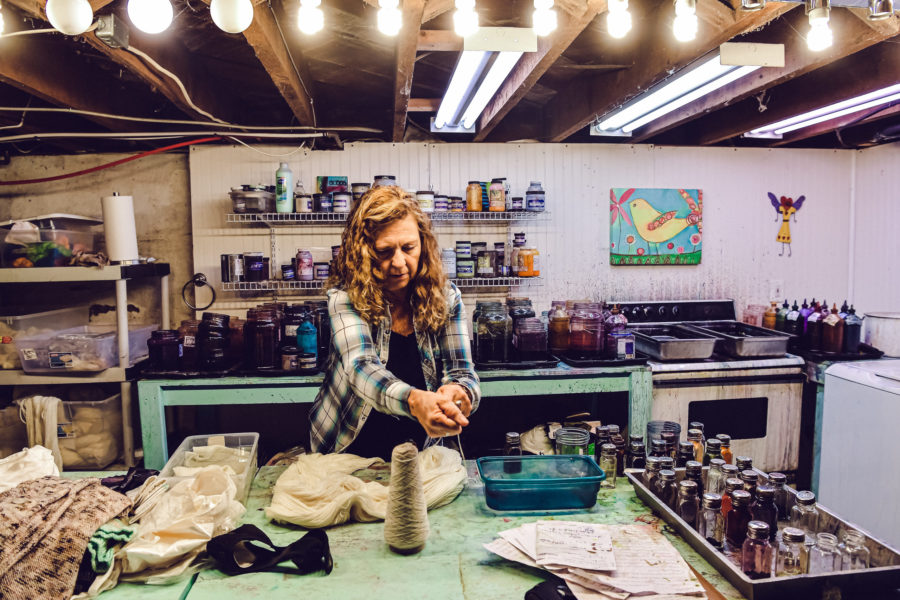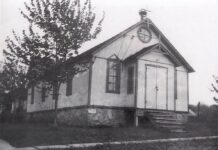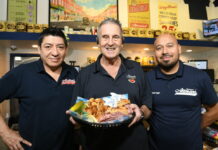
Dalis Davidson’s “autumn bouquet” channels the hues of the season in colors that range from chestnut to fir to something she’s named “chopping wood.” But this bouquet doesn’t feature the last flowers before frost. Rather, it’s a collection of yarns Davidson hand dyes on her Barnesville farm. She sells them from her studio and online, along with artwork she calls “lambscapes,” created in part with wool from the sheep she keeps.
Davidson and other farmers in upper Montgomery County harvest wool and alpaca fleece. Some then transform the fiber into vibrantly dyed scarves, blankets and artwork that they sell through websites and events such as the Maryland Sheep and Wool Festival, the largest such event in the country celebrating everything wooly.
Davidson’s Dancing Leaf Dyeworks is located in a cottage on her 2-acre farm overlooking Sugarloaf Mountain and the rounded ridges of the Catoctin mountains. The shelves and walls of her studio overflow with yarn saturated with color, kits to make shawls and blankets, hand-knitted items and “paintings” layered with various kinds of fiber.
When Davidson first moved to the farm in northwestern Montgomery County several decades ago, she adopted a sheep from a neighbor moving away. After shearing her for the first time, Davidson wasn’t sure what to do with the 14 pounds of wool.
“Luckily, there are a lot of female shepherds in the area, and they taught me to spin it. I learned to dye and knit and fell in love the whole process,” she says.
Today, she uses the wool from her two sheep, Delilah and Sunny Bunny, to create her lambscapes, which depict either mountains or beach scenes.
“They are English long wool breeds with gorgeous long locks that I shear once a year,” says Davidson. “Wool and bits of silk saris from India and yarn, that’s my palette for my paintings.”
However, Davidson’s primary business is dyeing wool and other fibers sourced from all over the world that she purchases from a supplier in New York. This includes ultra-soft yak fiber, camel hair and Angora goat fleece, which becomes mohair.
She uses vinegar-based acid dyes in powder form, eyeballing how much to add to stainless steel roasting pans purchased at kitchen goods stores.
“I use a lot of dye. I’m known for deep, saturated colors. What many people don’t know is that the deeper colors hide mistakes, whereas lighter ones are harder to create. But then sometimes mistakes turn into your most wonderful product,” she says.
Davidson says her yarns are “music-infused” because she always has something playing in the background as she works and “sun-kissed” because she hangs them in the sun to dry.
As she surveys her small parcel of farmland, which she shares with nine egg-laying chickens, two calico cats and a Labrador retriever, Davidson reflects on the need to preserve remaining county farms. Hers is in the county’s Agricultural Reserve, a rural swath of rolling land along Montgomery’s northern, western and eastern borders that covers nearly one-third of the county. Strict zoning rules protect farmland and agriculture, limiting development.
“During the pandemic, people have really used the Agriculture Reserve,” Davidson says. “People come out and say, ‘Wow, I can’t believe this is so close the city’. We couldn’t be here undisturbed unless it was held in preservation. That’s one reason I’ve been here so long.”
About four miles away from Davidson, Bev Thoms has also worked in fiber arts for decades. After a career as a nurse, she and her husband moved in 1974 from Rockville to a 60-acre farm and orchard in Dickerson. But half of their thousand peach trees soon died in a snowstorm.
“The branches couldn’t hold up, and they just cracked in half, sounding like gunfire,” she says.
They then boarded mares for a racing syndicate until it closed, moving on to raising sheep. Many in the first flocks, which were raised for meat, were killed by a neighbor’s Siberian husky. Once the dog moved away, Thoms began with sheep anew, this time raising them for their fiber.
This incarnation of the farm worked, although Thoms says, “I had no idea what to do with all that wool. So I taught myself to spin it.”
Thus began Tiewyan Textiles, the name derived from a Gaelic word that means “homestead of Williams,” for her husband’s family farming history in Wales. It is pronounced “tee-wee-an.”
But before the clouds of wool can be transformed into yarn, she sends it out for processing into roving, essentially long ropes of cleaned wool that has been straightened from sheep’s naturally curly coats.
After dyeing the roving using a process like Davidson’s and spinning it into yarn, Thoms initially wove it on a loom into clothing and blankets. But then she discovered felting about 15 years ago.
“Whereas weaving is very exacting and not so forgiving of mistakes, I found felting to be much more freeing, and I haven’t gone back to weaving” she says.
So her loom sits folded and covered in a corner of her studio. Pieces of new felting works in shades of purple line several long tables instead.
Thoms explains that wool can be transmuted into felt using a simple process. When dyed yarn meets soap and water, the small barbs at the edge of the fibers mesh together, forming sheets of felt once spread out and dried.
Thoms takes this a step further with a craft called nuno felting, developed about 20 years ago in Australia. This technique takes wet wool and bonds it to a fabric with a loose weave, like silk gauze. She sells felted silk and merino wool scarves in tones of maroon and teal. In one project, she repurposed a patterned-printed black silk scarf, crisscrossing with off-white wool fibers. She also fashions blankets and placemats using wool from her sheep. Thoms leaves some of them the natural colors of her flock, including Wallace’s brown, Sparkle’s gray and Mary’s white fleece.
To help connect with artists in all media from upper Montgomery County as well as close by areas of Frederick, Howard and Carroll counties, Davidson started a group called Countryside Artisans more than 20 years ago. In addition to Tiewyan Textiles, Breezy Hill Farm in Woodbine is a member that also creates fiber arts. Breezy Hill’s Heather Lysantri creates yarns, felted shawls and wraps, and woven scarves and table runners from the soft fleece of their alpacas, goats and sheep. She sells those as well as clothing and other works by other vendors specializing in alpaca fiber from her Little Boutique at Breezy Farm, which is attached to her studio.
Lysantri’s, Thoms’ and Davidson’s studios will be part of a 19-stop Countryside Artisans tour Oct. 8-10. The self-guided tour is free and will run again Dec. 3-5.
And for those looking for fiber to spin and dye themselves, it can be found at several Montgomery County outlets, including the Spinning Loft in Silver Spring. It sells raw fleece and processed roving from more than 50 breeds from around the world on its website.
“About 10 years ago knitting really took off and became immensely popular,” Davidson says. “With the pandemic and having people with time on their hands and wanting to get outside more, this is a great time to learn more about fiber arts and give them a try.”




